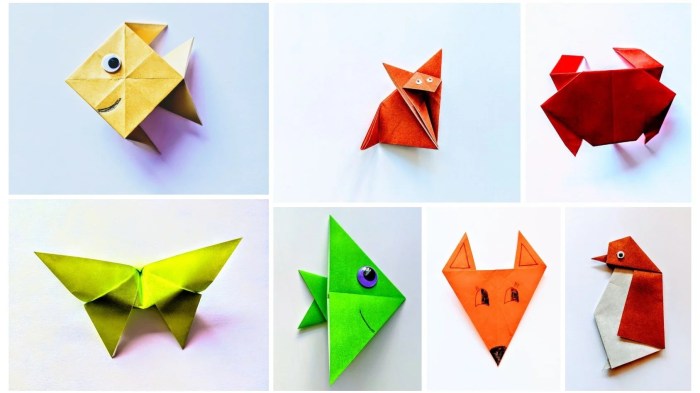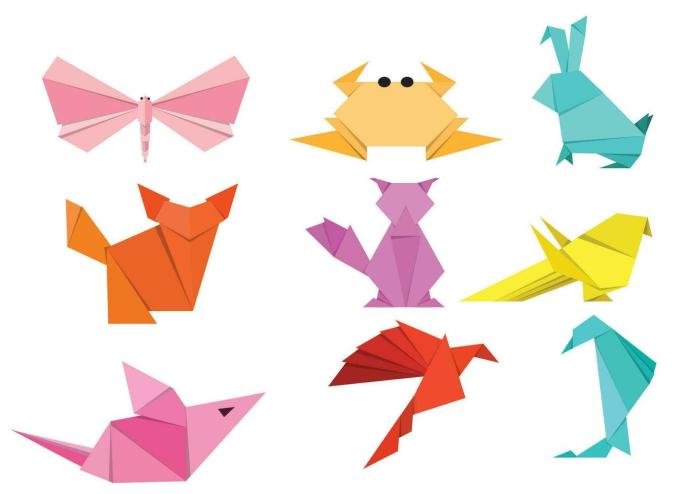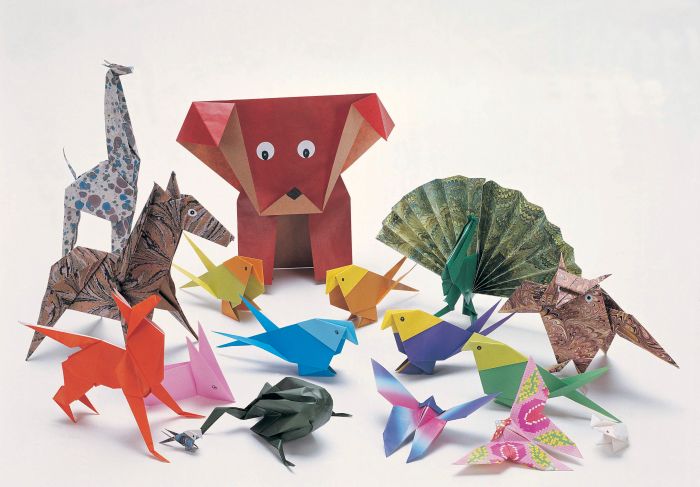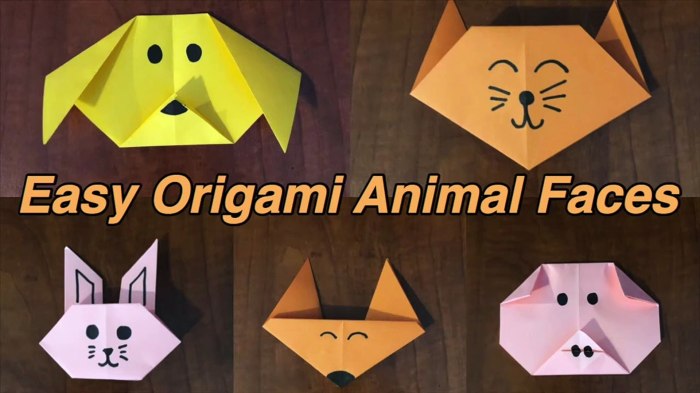How to Make 10 Different Origami Animals introduces the art of origami in creating a diverse range of animal shapes, promising an engaging journey filled with creativity and precision.
The guide covers essential folds, tools and materials, tips for beginners, intermediate and advanced animal designs, variations, display ideas, and fun facts.
Introduction to Origami Animals
Origami is the traditional Japanese art of paper folding, where intricate designs are created by folding a single piece of paper without the use of scissors or glue. This ancient practice requires precision, patience, and creativity to transform a flat sheet into various shapes, including animals.Origami holds significant cultural importance in Japan, where it is considered a form of art, meditation, and expression.
It has been passed down through generations, reflecting the values of patience, simplicity, and harmony with nature. The delicate and intricate designs of origami animals are often used in ceremonies, celebrations, and decorations.Making origami animals offers numerous benefits beyond the artistic expression. It enhances hand-eye coordination, improves concentration and focus, and stimulates the brain’s problem-solving skills. The process of folding paper can also be relaxing and meditative, reducing stress and promoting mindfulness.
The Art of Origami Animals
Origami animals are not just ordinary paper creations; they represent a harmonious blend of creativity, tradition, and mindfulness. Each fold and crease tells a story, capturing the essence and beauty of the animal being crafted.
Basic Origami Folds

Origami is an art form that involves intricate folding techniques to create various shapes and figures. Mastering the basic folds is essential to successfully creating origami animals and other designs.
Valley Fold
A valley fold is a simple fold where the paper is folded inward to create a “V” shape. Follow these steps to make a valley fold:
- Take the paper and fold it in half vertically.
- Unfold the paper and fold one edge to meet the center crease.
- Press along the fold to create a sharp crease.
- Unfold the paper to reveal the valley fold.
Mountain Fold
A mountain fold is the opposite of a valley fold, where the paper is folded outward. Here’s how to make a mountain fold:
- Start with a flat piece of paper.
- Fold the paper in half vertically and unfold it.
- Fold the edges to meet the center crease, but this time fold the paper outward.
- Press along the fold to create a sharp crease, forming a mountain fold.
Precise folding is crucial in origami to ensure the final design turns out as intended. Each fold must be crisp and exact to maintain the structural integrity of the paper and create intricate details in the origami animals.
Tools and Materials

When it comes to creating origami animals, there are a few essential tools and materials you will need to have on hand to ensure a successful folding experience.
Tools Needed for Making Origami Animals
- Origami paper
- Bone folder or scoring tool
- Ruler
- Scissors (for certain designs)
- Markers or pens (for adding details)
Types of Paper Suitable for Origami
- Traditional origami paper: Thin and colorful, specifically designed for origami projects.
- Kami paper: Slightly thicker than traditional origami paper, usually single-sided with a white back.
- Washi paper: Made from traditional Japanese fibers, Washi paper is strong and durable, ideal for complex origami models.
How Different Paper Textures or Thicknesses Can Affect the Final Origami Piece
- Thicker paper can be more challenging to fold, especially for intricate designs that require multiple folds.
- Thin paper allows for more delicate and precise folds, perfect for creating detailed features on origami animals.
- Paper with a glossy finish may be harder to fold neatly compared to matte paper, which provides better grip for creases.
Origami Animals
Origami animals are a popular choice for those who enjoy the art of paper folding. From simple designs like dogs to more intricate creations like swans, there is a wide range of animals that can be made through origami. It’s important to follow the steps carefully and avoid common mistakes to achieve the desired results.
Making a Simple Origami Dog
To make a simple origami dog, start with a square piece of paper. Follow these steps:
- Fold the paper in half diagonally to create a triangle.
- Bring the bottom corners of the triangle up to meet the top corner, forming a smaller triangle.
- Flip the paper over and fold the two bottom corners towards the center to create the dog’s legs.
- Finally, fold down the top corner to create the dog’s head and draw on eyes and a nose to complete the look.
Creating a Complex Origami Swan
For a more complex origami animal like a swan, you will need a larger square piece of paper. Follow these steps:
- Start with a square base by folding the paper in half both horizontally and vertically, then unfold.
- Fold the four corners of the paper towards the center point, creating a diamond shape.
- Flip the paper over and fold the bottom edge up to meet the top edge, then fold the two side corners in towards the center.
- Open up the folds to create the swan’s wings and neck, then shape the head by folding a small portion of the paper down.
- Your intricate origami swan is now complete!
Common Mistakes to Avoid
When folding origami animals, it’s important to be patient and precise. Common mistakes to avoid include:
- Rushing through the steps without paying attention to the details.
- Using paper that is too thick or thin, which can make folding difficult.
- Not creasing the folds properly, leading to a messy final result.
- Skipping steps or folding in the wrong direction, causing the animal to lose its shape.
- Getting frustrated and giving up before completing the folding process.
Tips for Beginners

Starting with origami animals can be a fun and rewarding experience, but it’s important to begin with simple designs to build your skills. Here are some tips to help beginners get started and improve their folding techniques.
Starting with Easy Origami Animals
- Begin with basic animal designs, such as a frog, fish, or bird, before moving on to more complex patterns.
- Choose origami tutorials or books specifically geared towards beginners to understand the folding techniques better.
- Practice folding the same design multiple times to improve muscle memory and dexterity.
Improving Precision and Neatness in Origami Folding
- Use thin and crisp origami paper to create precise folds and clean lines in your animal models.
- Make sure to crease the paper sharply and accurately to achieve a polished look in your final creation.
- Pay attention to small details and follow the folding instructions carefully to avoid mistakes and ensure neatness.
Choosing the Right Patterns for Beginners, How to Make 10 Different Origami Animals
- Look for origami patterns labeled as “easy” or “beginner-friendly” to start your origami animal journey.
- Opt for designs with fewer steps and simpler folding techniques to build confidence and skills gradually.
- Experiment with different animal shapes and sizes to find patterns that suit your level of expertise and interest.
Intermediate Origami Animals
Origami animals at an intermediate level require more intricate folds and techniques compared to basic designs. These creations offer a challenge for those looking to enhance their origami skills and patience. Here are examples of intermediate-level origami animals along with the techniques that make them more challenging.
1. Intermediate Origami Crane
The intermediate origami crane involves more complex folds and precise creases compared to the basic version. This design requires attention to detail and patience to achieve the intricate features of the crane.
2. Intermediate Origami Dragon
Creating an intermediate origami dragon involves advanced folding techniques to achieve the intricate details of the mythical creature. The dragon design often includes complex folds for the wings, tail, and body, making it a challenging yet rewarding origami project.
3. Intermediate Origami Butterfly
An intermediate origami butterfly involves more folds and precise shaping to capture the delicate features of the insect. This design requires attention to symmetry and detail to create a lifelike representation of a butterfly.
4. Intermediate Origami Elephant
Crafting an intermediate origami elephant requires advanced folding techniques to form the intricate shape of the animal. This design challenges origami enthusiasts to master complex folds and precise creases to create a realistic elephant figure.
5. Intermediate Origami Fox
The intermediate origami fox design involves intricate folds to capture the elegance and charm of the animal. This project challenges folders to create detailed features such as the ears, tail, and facial characteristics of a fox.
6. Intermediate Origami Swan
Creating an intermediate origami swan requires advanced folding techniques to achieve the graceful curves and intricate details of the bird. This design challenges folders to master complex folds and precise shaping to create a lifelike origami swan.
Advanced Origami Animals
Creating advanced origami animals like dragons or elephants requires precision and patience. These designs often involve intricate folds and shaping techniques that can be challenging but rewarding once mastered. Here are some tips to help you tackle complex origami animals:
Tips for Creating Advanced Origami Animals
- Start with high-quality paper: Use thin, durable paper specifically designed for origami to ensure crisp folds and intricate details.
- Practice basic folds: Mastering basic origami folds like mountain and valley folds will provide a strong foundation for tackling complex designs.
- Follow instructions carefully: Pay close attention to the step-by-step instructions, diagrams, or video tutorials to avoid mistakes and ensure accuracy.
- Use tools like a bone folder or tweezers: These tools can help you make precise creases and adjustments for intricate details.
- Work in a clean, well-lit space: A clutter-free workspace with good lighting will make it easier to focus and avoid errors while working on complex origami animals.
- Take breaks when needed: If you feel frustrated or fatigued, take a break and come back to your project with a fresh perspective to avoid making mistakes.
Origami Animal Variations

Origami animals have evolved over time to incorporate various cultural influences, resulting in a wide array of unique designs. Colors and patterns play a significant role in enhancing the appearance of these origami animals, adding depth and character to each creation. Let’s explore some fascinating variations in origami animal designs.
Cultural Influences on Origami Animals
Cultural influences have played a crucial role in shaping the designs of origami animals. Different regions have their own traditional origami styles, reflecting the flora, fauna, and mythology of the area. For example, Japanese origami often features animals like cranes and dragons, symbolizing longevity and good luck.
Colors and Patterns in Origami Animals
The use of vibrant colors and intricate patterns can transform a simple origami animal into a stunning work of art. Colors can convey emotions and symbolism, while patterns add texture and visual interest. Experimenting with different color combinations and patterns can help create visually striking origami animals.
Examples of Unique Origami Animal Variations
- 3D Origami Animals: Utilizing multiple folded pieces to create a three-dimensional effect, adding depth and realism to the final design.
- Kirigami Animals: Combining origami with paper cutting techniques to create intricate and detailed animal designs.
- Modular Origami Animals: Constructing animals using interconnected folded units, resulting in complex and impressive structures.
- Wet-Folded Origami Animals: Using dampened paper to create soft, organic shapes that mimic the natural forms of animals.
Origami Animal Display Ideas

Origami animals are not only beautiful creations but also versatile decorative items. Here are some creative ways to display origami animals and tips on how to use them for home decor or gifts.
Display Ideas
- Create a shadow box display with a variety of origami animals arranged in a visually appealing way. This can be hung on a wall or placed on a shelf to showcase your collection.
- Use origami animals as table centerpieces for parties or special occasions. They can add a unique touch to the decor and serve as conversation starters.
- Attach origami animals to string lights to create a whimsical garland that can be hung in a bedroom or living room for a playful decorative accent.
Home Decor and Gifts
- Origami animals can be framed individually or in a group to create eye-catching wall art. Consider using colorful paper or metallic finishes for a striking visual impact.
- Gift origami animals as personalized keepsakes for birthdays, holidays, or other celebrations. Attach a meaningful note or use them as embellishments on gift wrapping for a special touch.
- Incorporate origami animals into a terrarium or decorative bowl for a nature-inspired display that brings a touch of whimsy to any room.
Preserving Origami Creations
To ensure your origami animals stay in good condition for long-term display, consider using a clear coat spray to protect them from dust and moisture. Display them away from direct sunlight to prevent fading and store them in a dry, cool place when not in use.
Origami Animal Fun Facts
Origami animals have a rich history and cultural significance, with many interesting facts surrounding them. Let’s explore some fascinating information about origami animals.
Origami Animal Artists
Some famous origami animal artists have gained recognition for their intricate and detailed creations. Artists like Akira Yoshizawa and Robert J. Lang are known for their innovative origami animal designs that push the boundaries of the art form.
Origami Animal Exhibitions
Origami animal exhibitions around the world showcase the beauty and creativity of these folded creatures. Events like the Origami USA Convention and the International Origami Olympiad feature stunning displays of origami animals created by talented artists.
Origami Animals in Modern Art and Design
Origami animals have become a popular motif in modern art and design, appearing in various forms such as sculptures, installations, and even fashion. The clean lines and geometric shapes of origami animals have inspired contemporary artists and designers to incorporate them into their work.
Final Review: How To Make 10 Different Origami Animals
Explore the world of origami animals with How to Make 10 Different Origami Animals and unleash your artistic potential through the captivating art of paper folding.